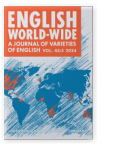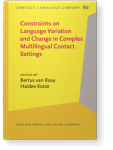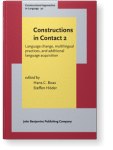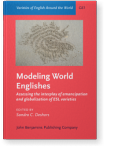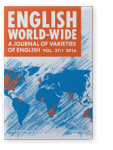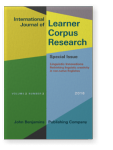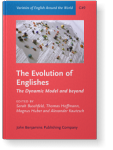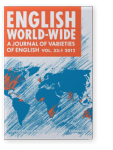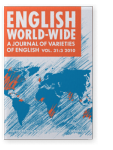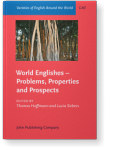Bertus van Rooy
List of John Benjamins publications for which Bertus van Rooy plays a role.
Journals
ISSN 2215-1478 | E-ISSN 2215-1486
Title
Constraints on Language Variation and Change in Complex Multilingual Contact Settings
Edited by Bertus van Rooy and Haidee Kotze
[Contact Language Library, 60] 2024. vi, 293 pp.
Subjects Contact Linguistics | Historical linguistics | Multilingualism | Sociolinguistics and Dialectology | Theoretical linguistics
2024 Chapter 1. Introduction: The constrained communication framework for studying contact-influenced varieties Constraints on Language Variation and Change in Complex Multilingual Contact Settings, van Rooy, Bertus and Haidee Kotze (eds.), pp. 1–28 | Chapter
This introductory chapter sketches an overview of the origins of and background to the constrained language (or constrained communication) framework that informs this volume. It outlines the five constraint dimensions identified in the framework, and the usage-based theoretical grounding of the… read more
2024 Chapter 9. Conclusion: Cumulative insights into constrained communication Constraints on Language Variation and Change in Complex Multilingual Contact Settings, van Rooy, Bertus and Haidee Kotze (eds.), pp. 255–286 | Chapter
This chapter synthesises the findings of the chapters in this volume and takes stock of cumulative insights into constrained communication. It considers the effects of the individual constraint dimensions in respect of their consequences for different aspects of language use, including… read more
2023 Chapter 2. Salient differences between Australian oral parliamentary discourse and its official written records: A comparison of ‘close’ and ‘distant’ analysis methods Exploring Language and Society with Big Data: Parliamentary discourse across time and space, Korhonen, Minna, Haidee Kotze and Jukka Tyrkkö (eds.), pp. 54–88 | Chapter
This chapter addresses the question of editorial practice for the Australian Hansard with the use of an aligned corpus of transcribed audio recordings and the corresponding Hansard records, covering the period 1946–2015. A more traditional, qualitative, bottom-up approach is taken by manually… read more
2021 A Diasystematic Construction Grammar analysis of language change in the Afrikaans and English finite verb complement clause construction Constructions in Contact 2: Language change, multilingual practices, and additional language acquisition, Boas, Hans C. and Steffen Höder (eds.), pp. 109–137 | Chapter
Afrikaans adopted a new formal variant of the complement clause during language contact from English, the variant that allows omission of the overt complementiser. Based on a corpus analysis of letters from the 18th century to the end of the 20th century, the forms and semantic functions of the… read more
2019 Chapter 1.2. Corpus-based research on English in Africa: A practical introduction Corpus Linguistics and African Englishes, Esimaje, Alexandra U., Ulrike Gut and Bassey E. Antia (eds.), pp. 37–70 | Chapter
This chapter provides linguists and students not yet familiar with corpus-based research on varieties of English in Africa with a practical introduction to the field. After explaining the rationale and aims of corpus-based research on varieties of English (in Africa), we introduce methods, tools… read more
2019 Chapter 2.1. Evaluating explanations for past-time reference with unmarked verb forms in African Englishes Corpus Linguistics and African Englishes, Esimaje, Alexandra U., Ulrike Gut and Bassey E. Antia (eds.), pp. 185–204 | Chapter
Previous research suggests that some varieties of English in Africa do not mark the past tense consistently with an inflectional suffix. Various explanations are offered for this state of affairs, including the option of the historical present tense, non-marking because the context already makes… read more
2018 Register variation in written contact varieties of English: A multidimensional analysis English World-Wide 39:2, pp. 214–242 | Article
Previous research suggests there are register differences between native and non-native varieties of English, as well as translated English. This article reports on a multidimensional (MD) analysis of register variation in the published written registers of 16 varieties of English, and tests… read more
2018 Hybridity, globalisation and models of Englishes: English in South African multilingual digital repertoires Modeling World Englishes: Assessing the interplay of emancipation and globalization of ESL varieties, Deshors, Sandra C. (ed.), pp. 77–108 | Chapter
Current models of Englishes face empirical challenges, such as multilingualism, hybrid varieties, complex identities, online communication and other consequences of globalisation, alongside a number of conceptual and methodological challenges. In this chapter, we explicate these challenges, and… read more
2018 The innovative progressive aspect of Black South African English: The role of language proficiency and normative processes Rethinking Linguistic Creativity in Non-native Englishes, Deshors, Sandra C., Sandra Götz and Samantha Laporte (eds.), pp. 75–98 | Article
Conflicting findings are reported for New Englishes and Learner Englishes:similarities are identified mainly on psycholinguistic grounds and differences on sociolinguistic grounds. This chapter offers an analysis of the progressive form in Black South African English, in which the interaction… read more
2016 Constrained language: A multidimensional analysis of translated English and a non-native indigenised variety of English English World-Wide 37:1, pp. 26–57 | Article
Translation and non-native indigenised varieties of English are produced in contexts where heightened constraints operate on them. Recurrent features of translated language include explicitation, normalisation or conventionalisation, simplification, and homogenisation. Similar features in… read more
2016 The innovative progressive aspect of Black South African English: The role of language proficiency and normative processes Linguistic Innovations: Rethinking linguistic creativity in non-native Englishes, Deshors, Sandra C., Sandra Götz and Samantha Laporte (eds.), pp. 205–228 | Article
Conflicting findings are reported for New Englishes and Learner Englishes: similarities are identified mainly on psycholinguistic grounds and differences on sociolinguistic grounds. This article offers an analysis of the progressive form in Black South African English, in which the interaction… read more
2015 The development of an extended time period meaning of the progressive in Black South African English Grammatical Change in English World-Wide, Collins, Peter (ed.), pp. 465–484 | Article
This chapter examines the use of the progressive aspect in Black South African English (BSAfE) since the late 19th century in corpora of fiction and newspapers. Previous research points to on-going change in native varieties and the extension to stative contexts in non-native varieties of English.… read more
2014 Convergence and endonormativity at Phase Four of the Dynamic Model The Evolution of Englishes: The Dynamic Model and beyond, Buschfeld, Sarah, Thomas Hoffmann, Magnus Huber and Alexander Kautzsch (eds.), pp. 21–38 | Article
At Phase 4 of the Dynamic Model, Schneider (2007) postulates that a stable postcolonial English will gain acceptance in a country, and become endonormative, but it will also be perceived as homogenous. This paper argues that, in a postcolonial language contact situation, multiple contact settings… read more
2012 Diachronic changes in modality in South African English English World-Wide 33:1, pp. 1–26 | Article
In this paper we aim to contribute to both the synchronic and diachronic description of the grammar of South African English (SAfE) in its written register. In the handful of previous studies on the variety’s grammar (e.g. Bowerman 2004b) the traditional method of pointing out peculiarities has… read more
2011 A principled distinction between error and conventionalized innovation in African Englishes Exploring Second-Language Varieties of English and Learner Englishes: Bridging a paradigm gap, Mukherjee, Joybrato and Marianne Hundt (eds.), pp. 189–208 | Article
A distinction between error and conventionalized innovation is essential to understanding if and how New Varieties of English develop new conventions. This chapter proposes two criteria, grammatical stability and acceptability, to identify conventionalized innovations. It draws on the distinction… read more
2010 Register differentiation in East African English: A multidimensional study English World-Wide 31:3, pp. 311–349 | Article
The article examines register variation in East African English by submitting the East African component of the International Corpus of English (ICE) to a complete multidimensional analysis (Biber 1988). A six-factor model was extracted using 67 linguistic features (Biber 1988). The results show… read more
2009 The shared core of the perfect across Englishes: A corpus-based analysis World Englishes – Problems, Properties and Prospects: Selected papers from the 13th IAWE conference, Hoffmann, Thomas and Lucia Siebers (eds.), pp. 309–330 | Article
The perfect aspect has not received extensive attention in the study of varieties of English, but its interpretation as aspect or secondary tense is debated by grammarians of (Standard) English. This paper examines the semantics of the perfect in ICE corpora of three varieties, Great Britain, East… read more
2008 A multidimensional analysis of student writing in Black South African English English World-Wide 29:3, pp. 268–305 | Article
Evidence for the status of Black South African English (BlSAfE) as a variety of English is ambiguous. This paper examines 67 linguistic features of a corpus of BlSAfE student writing, the Tswana Learner English Corpus (TLE), in comparison to a Standard English reference corpus, the Louvain Corpus… read more
